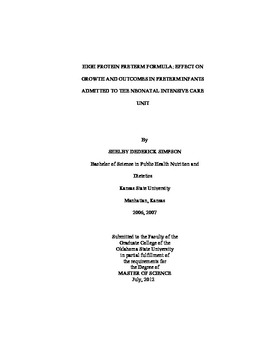| dc.contributor.author | Simpson, Shelby Dederick | |
| dc.date.accessioned | 2014-04-15T22:01:41Z | |
| dc.date.available | 2014-04-15T22:01:41Z | |
| dc.date.issued | 2012-07-01 | |
| dc.identifier.uri | https://hdl.handle.net/11244/9282 | |
| dc.description.abstract | The purpose of this study was to evaluate if increasing the amount of protein provided to preterm infants improved growth and blood urea nitrogen levels without adverse outcomes. Additional expected outcomes were a decrease in infants with extrauterine growth restriction. Adverse outcomes such as length of stay, incidence of necrotizing enterocolitis, sepsis and mortality were also assessed. The design of the study was a retrospective chart review utilizing a convenience sample from a local hospital's neonatal intensive care unit. The hospital had recently changed from a traditional formula to a higher protein formula. Singleton infants with a birth weight between 600 and 2500 grams and gestation at birth >24 to <37 weeks, admitted to the NICU during the six months prior to the unit's transition to high protein formula in December 2010 and six months after the transition were included. Differences in extrauterine growth restriction and adverse outcomes were assessed by t- tests or chi-square. Hierarchical linear modeling was used to assess the primary hypothesis of differences in weight gain and blood urea nitrogen between groups. Infants in both the traditional formula group (n= 60) and the high protein formula group (n = 54) were similar with the majority of infants being classified as white with a mean gestational age of ~31 weeks. There was an improvement in growth of 8.4 grams per day with every day an infant remained on the higher protein product. There was also an increase in BUN of 0.16 mg/dL for every day an infant received the higher protein preterm formula. The infants in the traditional preterm formula group were discharged at a higher weight (p=.014), but were also admitted to the unit for 11 days more on average (p= .10). Sepsis was diagnosed more frequently in the traditional preterm formula group (p= .08). The higher protein formula lead to better daily growth and improvements in blood urea nitrogen, a measure of protein status. The higher protein product did not increase adverse outcomes, but did demonstrate clinically important trends toward decreased incidence of sepsis, and shortened length of stay. | |
| dc.format | application/pdf | |
| dc.language | en_US | |
| dc.publisher | Oklahoma State University | |
| dc.rights | Copyright is held by the author who has granted the Oklahoma State University Library the non-exclusive right to share this material in its institutional repository. Contact Digital Library Services at lib-dls@okstate.edu or 405-744-9161 for the permission policy on the use, reproduction or distribution of this material. | |
| dc.title | High Protein Preterm Formula: Effect on Growth and Outcomes in Preterm Infants Admitted to the Neonatal Intensive Care Unit | |
| dc.type | text | |
| osu.filename | Simpson_okstate_0664M_12323.pdf | |
| osu.college | Human Environmental Sciences | |
| osu.accesstype | Open Access | |
| dc.description.department | Department of Nutritional Sciences | |
| dc.type.genre | Thesis | |
| dc.subject.keywords | blood urea nitrogen | |
| dc.subject.keywords | high protein formula | |
| dc.subject.keywords | preterm infant growth | |
| dc.subject.keywords | preterm infants | |
